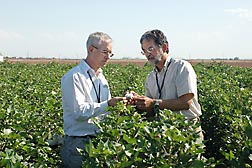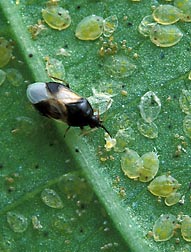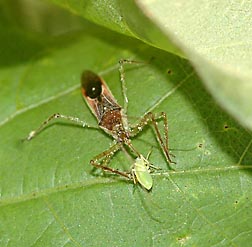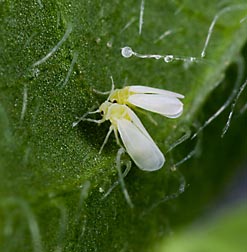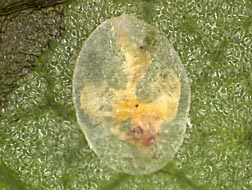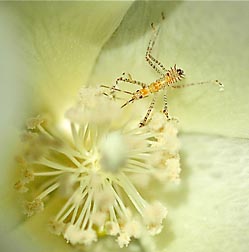Integrated Control System Improves Cotton Health
Pirate bugs, assassin bugs, and collops beetles sound dangerous, and they are. That is, if you’re a sweetpotato whitefly (Bemisia tabaci), a common cotton pest in Arizona that is a target of those bugs and more than a dozen different predators. Steve Naranjo, an Agricultural Research Service entomologist and research leader at the USDA-ARS Arid-Land Agricultural Research Center in Maricopa, Arizona, is trying to make sure those predators and other natural enemies are well represented in that state’s cotton fields.
His reason is simple. If you enhance the environment for predators of a pest, those predators will attack the pest so that you can keep insecticide use to a minimum. The concept is known as “integrated control.”
“You want to foster the effects of parasitoids and predators that are already in the field, so that they work as natural controls,” Naranjo says.
|
|
Historically, cotton has been plagued by dozens of pests, and in the early 1990s it was common for growers in Arizona to spray 12 or 13 times a season to control them. The arrival in 1996 of Bt cotton, engineered with the Bacillus thuringiensis gene to produce moth-killing proteins, gradually eliminated the need to spray broad-spectrum insecticides for caterpillar pests like the pink bollworm. But the Bt proteins did not affect sucking insects like whiteflies, making it necessary for growers to continue using broad-spectrum insecticides, which also threatened the natural biological control agents. Even when sprays were developed that specifically targeted whiteflies, some growers continued to use broad-spectrum insecticides to control them.
Over the years, Naranjo’s research has explored how Arizona cotton growers can use the integrated-control approach to minimize insecticide use without affecting crop yields. His efforts, along with the introduction of Bt cotton and the work of other scientists, are paying off. It’s now common for many Arizona cotton growers to spray no more than once a season, and in a paper published in Pest Management Science, Naranjo estimates that since 1995, the approach has reduced insecticide spraying in Arizona by about 70 percent and produced a net gain of more than $200 million for growers because of reduced spraying costs and increased yields.
|
|
Spray the Whiteflies, Not the Predators
Naranjo and Peter Ellsworth at the University of Arizona’s Maricopa Agricultural Center conducted a 3-year study where they treated large plots with insecticides specific to whiteflies and other plots with broad-spectrum insecticides, which kill a variety of pests. They left a third set of plots as untreated controls. The goal was to find the treatment that would minimize the need for spraying by fostering activity among the whitefly predators.
The results, published in Biological Control, showed that whiteflies initially died off at about the same rate in areas treated with both the whitefly-specific and the broad-spectrum insecticides. But as the growing season continued, differences emerged. The area sprayed with broad-spectrum insecticides had to be repeatedly sprayed to control whiteflies, while there was no need to continue spraying the area treated once with the whitefly-specific insecticide. In those areas, the whitefly’s natural enemies survived the initial spraying and continued to feed on whiteflies. Naranjo and Ellsworth coined the term “bioresidual” to describe the extended environmental resistance that is possible from biological control when selective insecticides are used. Such effects were consistent throughout the 3 years of field experiments that covered 10 to 20 acres per year.
|
|
Naranjo has used the study results to develop “life tables” for whiteflies, similar to mortality tables used by life insurance companies to calculate the policy prices for their clients depending on their age, gender, and health-related habits. Scientists could use Naranjo’s life-table approach to spell out how likely it is under different scenarios for whiteflies to be eaten by predators, parasitized by wasps, or blown off host plants by wind and rain.
“These results have allowed us to specifically measure the contribution of conserving the whitefly’s natural enemies,” says Naranjo.
Stay on the Alert After the Cantaloupe Harvest!
In other work, Naranjo and Ellsworth have uncovered evidence about whitefly feeding and migration patterns that will be helpful to growers. Whiteflies attack a wide range of crops, and one of their favorites is cantaloupe, which is grown near cotton in much of Arizona. There, cotton is planted in April and peaks in summer, and cantaloupe is harvested starting in June. In their 20-day life cycle, whiteflies move from cantaloupe fields after harvest to cotton fields and cause serious damage.
|
|
“The sudden influx of such large numbers of whiteflies to cotton overwhelms whitefly natural enemies,” Naranjo says. The migration of whiteflies from cantaloupe to cotton has been a persistent problem, but growers are reluctant to switch to other crops because both are relatively profitable.
Naranjo and Ellsworth found that whiteflies typically reach excessive levels on cotton in July, coinciding with the end of the cantaloupe harvest and the passing of enough time for pest populations to grow after their initial invasion of cotton. But they found that a single application of whitefly-specific insecticides on cotton at this time preserved a sufficient supply of natural enemies and caused a “knock down” of whitefly populations to levels where those enemies could then control the whiteflies the rest of the growing season.
The results, described in Biological Control and Pest Management Science, show the benefits of using insecticides designed specifically to control whiteflies.
|
|
Naranjo also evaluates new insecticides, works with cooperative extension agents to distribute control guidelines to growers, and explores ways to use chemical attractants to increase the numbers of whitefly predators and parasitoids in cotton fields. He also is studying insecticides available to cotton growers specifically to control plant bugs, another major cotton pest.
“Our overall goal has been to encourage growers to use insecticides, if needed, that are selective. We want to arm growers with the newest and latest technology available, and as part of that focus, we’re always testing new products and identifying those that are selective,” says Naranjo.—By Dennis O'Brien, Agricultural Research Service Information Staff.
This research is part of Crop Protection and Quarantine (#304), an ARS national program described at www.nps.ars.usda.gov.
Steven Naranjo is with the USDA-ARS U.S. Arid-Land Agricultural Research Center, 21881 N. Cardon Ln., Maricopa, AZ 85138; (520) 316-6333.
"Integrated Control System Improves Cotton Health" was published in the November/December 2011 issue of Agricultural Research magazine.







